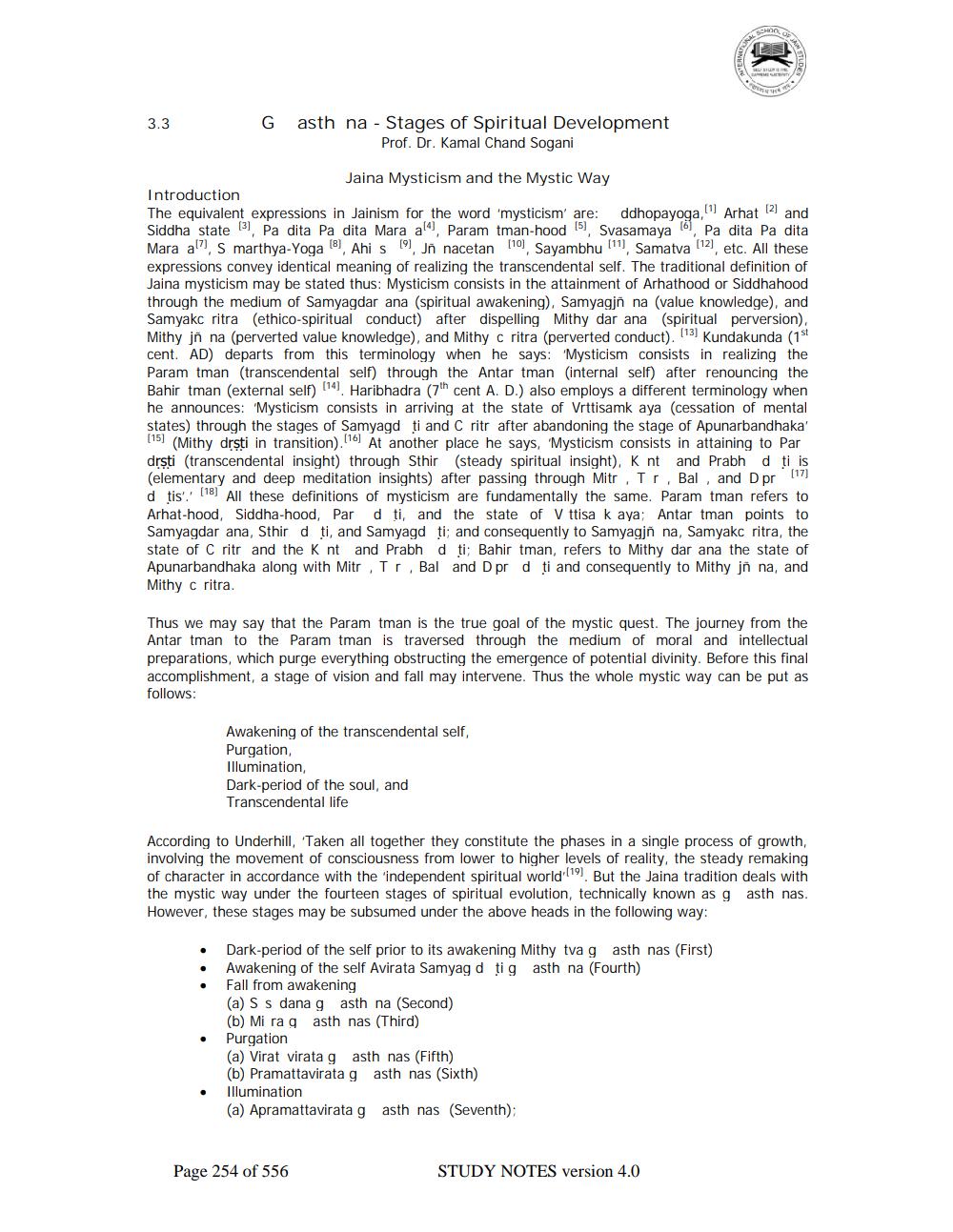________________
3.3
G
asth na - Stages of Spiritual Development
Prof. Dr. Kamal Chand Sogani
Jaina Mysticism and the Mystic Way Introduction The equivalent expressions in Jainism for the word 'mysticism' are: ddhopayoga, Arhat 12 and Siddha state 13. Pa dita Pa dita Mara a Param tman-hood 15). Svasamaya 6 Pa dita Pa dita Mara all, s marthya-Yoga (8), Ahi s 19), un nacetan [10), Sayambhu '11), Samatva '12), etc. All these expressions convey identical meaning of realizing the transcendental self. The traditional definition of Jaina mysticism may be stated thus: Mysticism consists in the attainment of Arhathood or Siddhahood through the medium of Samyagdar ana (spiritual awakening), Samyagjin na (value knowledge), and Samyakc ritra (ethico-spiritual conduct) after dispelling Mithy dar ana (spiritual perversion) Mithy jň na (perverted value knowledge), and Mithy c ritra (perverted conduct). (13) Kundakunda (1st cent. AD) departs from this terminology when he says: 'Mysticism consists in realizing the Param tman (transcendental self) through the Antar tman (internal self) after renouncing the Bahir tman (external self) 14 Haribhadra (7th cent A. D.) also employs a different terminology when he announces: 'Mysticism consists in arriving at the state of Vrttisamk aya (cessation of mental states) through the stages of Samyagd ti and C ritr after abandoning the stage of Apunarbandhaka 115) (Mithy drsti in transition). 16 At another place he says, "Mysticism consists in attaining to Par drsti (transcendental insight) through Sthir (steady spiritual insight). K nt and Prabh d ti is (elementary and deep meditation insights) after passing through Mitr, Ir, Bal, and Dpr 117] d tis'. [18] All these definitions of mysticism are fundamentally the same. Param tman refers to Arhat-hood, Siddha-hood, Pardti, and the state of V ttisa k aya; Antar tman points to Samyagdar ana, Sthird ti, and Samyagd ti; and consequently to Samyagjn na, Samyakc ritra, the state of Critr and the K nt and Prabh dti Bahir tman, refers to Mithy dar ana the state of Apunarbandhaka along with Mitr, Ir, Bal and Dprd ti and consequently to Mithy jn na, and Mithy c ritra.
Thus we may say that the Param tman is the true goal of the mystic quest. The journey from the Antar tman to the Param tman is traversed through the medium of moral and intellectual preparations, which purge everything obstructing the emergence of potential divinity. Before this final accomplishment, a stage of vision and fall may intervene. Thus the whole mystic way can be put as follows:
Awakening of the transcendental self, Purgation, Illumination Dark-period of the soul, and Transcendental life
According to Underhill, 'Taken all together they constitute the phases in a single process of growth, involving the movement of consciousness from lower to higher levels of reality, the steady remaking of character in accordance with the 'independent spiritual world 19). But the Jaina tradition deals with the mystic way under the fourteen stages of spiritual evolution, technically known as g asth nas. However, these stages may be subsumed under the above heads in the following way:
Dark-period of the self prior to its awakening Mithy tva g asth nas (First) Awakening of the self Avirata Samyag d ti g asth na (Fourth) Fall from awakening (a) S S dana g asth na (Second) (b) Mi rag asth nas (Third) Purgation (a) Virat virata g asth nas (Fifth) (b) Pramattavirata g asth nas (Sixth) Illumination (a) Apramattavirata g asth nas (Seventh);
Page 254 of 556
STUDY NOTES version 4.0




